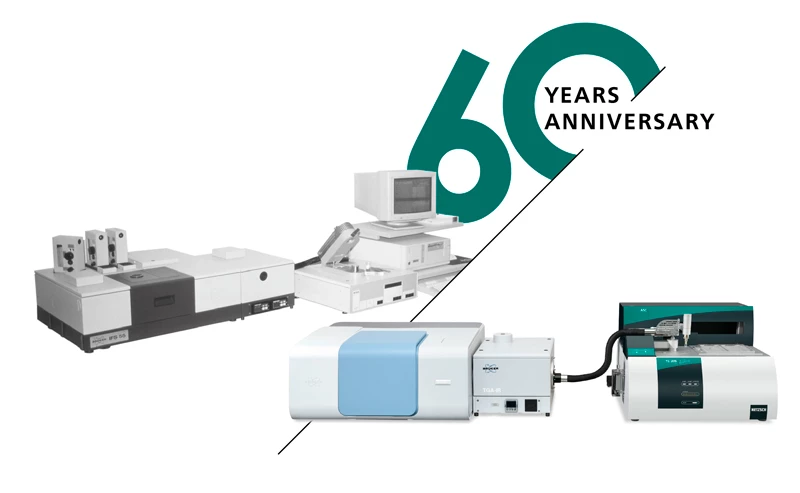
14.03.2022 by Erwin Kaisersberger
The Largest “NETZSCH Laboratory” outside from NETZSCH in Selb
In the past two weeks, you have learned a lot about the development and history of our coupling systems. Today, among other things, we show you, what is supposed to be the largest NETZSCH laboratory, but is not a NETZSCH company. ? Also learn, how coupling systems have evolved until today and what makes them unique.
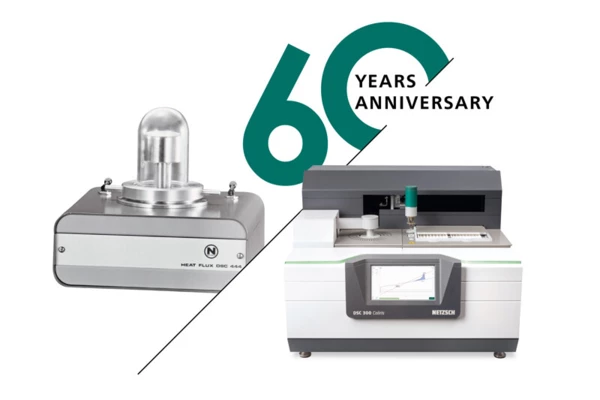
In the past two weeks, you have learned a lot about the development and history of our coupling systems. Today, among other things, we show you, what is supposed to be the largest NETZSCH laboratory, but is not a NETZSCH company. ?
Erwin Kaisersberger continues in the explanation of the coupling history:
The Largest “NETZSCH Laboratory” outside from NETZSCH in Selb
It may be permitted at this point to mention the largest “NETZSCH laboratory” outside Selb: Europe’s best-equipped thermal analysis laboratory for ceramic technologies and powder metallurgy has grown in Dresden at the Fraunhofer Institute for Ceramic Technologies and Systems, IKTS. Starting with initial acquisitions at the Central Institute for Solid State Physics and Materials Research at the Academy of Sciences of the GDR (STA 429 with Dr. Hesselbart), laboratory expansion continued after the founding of IKTS in 1992 with Dr. Gert Leitner (d. 2019) and Klaus Jaenicke-Rößler. The instruments were arranged in an exemplary way and provided with perfectly installed high-purity gas supply. Starting from the later 1990s, the entire equipment collection today comprises:
Accredited measuring stations:
- Simultaneous thermal analyzers (STA 449 F1 , 429, 429 C, 409); some of which are coupled (capillaries, orifices or Skimmer) with:
- Mass spectrometers (QMS 403 C, QMG 420, 421, 422)
- FT-IR spectroscope (Tensor27)
- Macro thermobalance (MTG 419/NGB)
- Thermomechanical analyzers (TMA 402)
- Thermo dilatometers (DIL 402 and DIL E7)
- Differential scanning calorimeters (DSC 404, 404 C and DSC 7)
- Laser Flash Analyzer (LFA 427)
- Light Flash Analyzer (NanoFlash) (LFA 447)
- Thermal conductivity tester (TCT 416)
Available at all facilities: automated laboratory gas supply system for mixing and doping of high-purity atmospheres, pressure range from high vacuum to normal pressure, and capability for gas analysis with a transportable mass spectrometer.

Today, the thermal analysis and thermophysics department of IKTS is headed by Dr. Tim Gestrich, who can look back on many years of experience in the special subject area for application-oriented modern high-performance ceramic materials, industry-relevant manufacturing processes and prototype components.
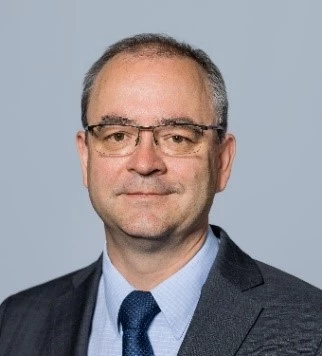
Dr.-Ing. Tim Gestrich, Fraunhofer Institute for Ceramic Technologies and Systems IKTS, Team Leader for Thermal Analysis and Thermophysics
Our many years of working with elaborate coupling methods for mass spectrometry did not prevent us from noticing the fact that a large number of customers were either unable to afford these systems or unwilling to spend on them. In addition, even the most elaborate direct couplings to mass spectrometers are hindered by the fact that the results are difficult to interpret; thus, computerized control and evaluation by means of specially developed software have certainly found their way into the laboratories. However, difficulties in interpreting MS spectra continued to arise in some applications due to fragmentation (thermal and electron impact ionization), background peaks (carrier gas, impurities), and transfer losses for sample gases (distances, condensation), especially when it came to investigating organic samples.
1993: Coupling to FT-IR Spectrometers
The search for alternative gas analysis methods was a current topic in the early 1990s. That was when I set out with a thermobalance to “specialists” in FT-IR gas analysis (Fourier transform infrared spectroscopy) from 1992 to 1993.
After several unfruitful contacts to FT-IR manufacturers, I set out again with an instrument in the trunk of my car: This time, I went to Bruker in Karlsruhe, Germany. With proficient support from the Bruker applications laboratory, the newly developed TG 209 was quickly connected to the awaiting FT-IR instrument with gas measuring cell. The outcome, following several visits and tests, was a compact yet flexible experimental setup combining all the advantages of TGA and FT-IR in an optimum way.
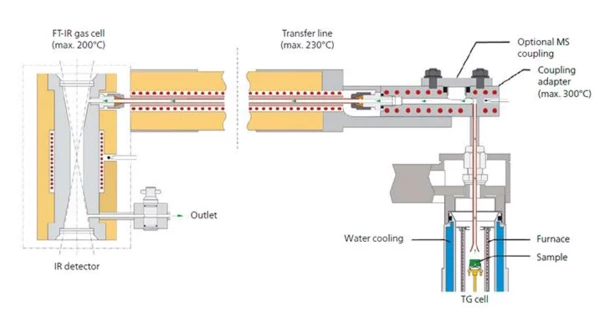
Coupling with FT-IR instruments by Bruker Optics has been continuously developed and adapted, also for the new instrument versions at Bruker and NETZSCH: PERSEUS® is the patented combination of the Bruker ALPHA II, a small, powerful FT-IR spectrometer, with NETZSCH thermoanalytical instruments. The TG 209 F1 Libra® and STA 449 F1 /F3 can be upgraded to the PERSEUS® configuration in a cost-effective and space-saving way, with furnace possibilities reaching up to 2000°C on the STA. Flexible software solutions allow for the integrated evaluation of thermoanalytical and FT-IR measurement results.
1997 Introduction of PulseTA for Calibration of Gas Analysis Systems Coupled to Thermal Analysis
In the mid-1990s, Dr. Marek Maciejewski under the chair of Prof. Dr. A. Baiker, Technical Chemistry, ETH Zürich, Switzerland, developed a device on an STA 409 C with capillary coupling for the Balzers mass spectrometer for introducing precise quantities of calibration gases into the sample gas stream in a pulse-like manner; hence the name “PulseTA”. By means of this online calibration, it became easy to quantify mass spectrometer signals for gases coming from the sample, gases adsorbed by the sample, and reaction gases. Particularly in catalysis research, PulseTA® has proven itself worthwhile.

1999: Start of a Series of International Conferences on the Coupling of Gas Analysis Methods to Thermal Analysis Instruments and Its Applications:
Selb Coupling Days, SKT

2003: Introduction of the NETZSCH Aëolos® Mass Spectrometer
Being heavily affected by our supplier companies’ product policies and changes in name, along with the difficulties of having equal ranking with competitors in the procurement of compact, mobile mass spectrometers, prompted NETZSCH to launch its “own” mass spectrometer onto the market: Aëolos® was developed in collaboration with IPI Bremen. Our special thanks go to Dr. Adolf Götz, who significantly contributed to our joint success.
“Aëolos®” features an integrated design, with pumps and electronics in a housing along with an optimized gas inlet system, and is thereby specially designed for coupling to gas-tight thermal analyzers. The gas inlet consists of a continuously heated capillary without any need for an orifice. This avoids occlusion of the orifice by the evaporation and condensation of Decomposition reactionA decomposition reaction is a thermally induced reaction of a chemical compound forming solid and/or gaseous products. decomposition products, which otherwise occurs frequently.
Aëolos®has been further developed over the last decades and now, in its 4th generation (Aëolos® Quadro), features exceptional technical performance along with complete integration of the software for the TGA/STA and MS system. The software integration in particular is unique on the coupling market and allows for the execution of every relevant work step (programming, control and evaluation) of a TGA-MS combination by means of a single software solution.


In order to be able to simultaneously use the complementary gas analysis information yielded by the Aëolos®mass spectrometer and the Bruker FT-IR, the heated adapter for gas sampling above the furnace was equipped with a connection for both the MS capillary and the FT-IR transfer line.
2010: Introduction of the GC-MS Coupling
The gas analysis methods discussed so far all have something in common when it comes to the coupling of thermal analyzers, and that is that they must analyze all changes in gas composition all at once. In inorganic applications, it may even be more common for individual gas species to be split off separately (with a temperature-dependent time delay); in organic applications, on the other hand, especially in the emerging research on biomass fuels, one is almost always dealing with larger volatile molecules and simultaneous split-off of gas mixtures. Here, an intermediate step is recommended for the temporal separation of gas mixtures prior to identification with the mass spectrometer. Gas chromatography provides an ideal means for separating gas mixtures by selecting appropriate separation columns (coated capillaries) and carrier gases. In most cases, these advantages of gas separation outweigh the disadvantage that the continuous operation afforded by direct coupling with MS or FT-IR is no longer possible. The sample gas is drawn into a valve box by means of the heated transfer line and then injected intermittently into the separation capillary of the GC by the programmable valve circuit. The recorded MS spectra of the gas ions arriving separately in time can then usually be clearly interpreted.
With our development partner for GC-MS couplings, Joint Analytical Systems GmbH (JAS), a heatable valve circuit for the gas sampling capillary was adapted from the TG/STA and further developed into a compact NETZSCH valve box in 2017.
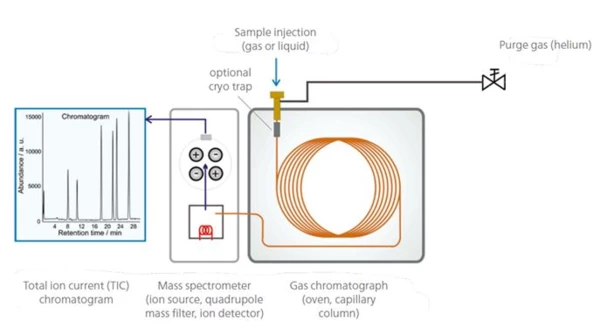
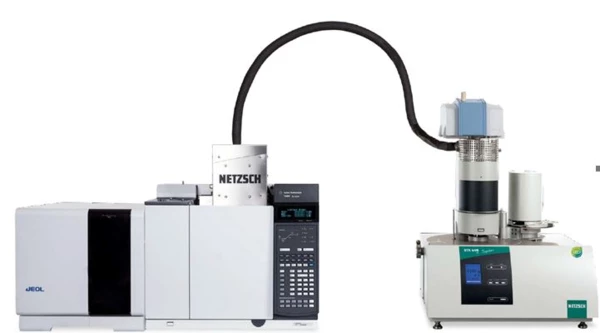
Coupling Systems for Nearly Any Application
In the 60 years since the establishment of NETZSCH-Gerätebau GmbH as an independent business unit of the NETZSCH Group, more than 50 years have been dedicated to the subject of gas detection and gas analysis. With these many years of creative activity, NETZSCH achieved high and globally recognized proficiency in this important market sector within thermal analysis. This is the merit of a forward-looking company strategy and, in particular, also of the many people involved in development, technology, electronics, production, applications and service. The drive for new things, based on the wishes and demands of numerous customers, has always been high priority at NETZSCH.
The coupling solutions realized are by no means in competition with one another; each has advantages of its own:
- continuous and complete gas analysis, directly at the point of origin (at the same temperature and time) with the Skimmer system
- Continuous and complete analysis of all gases transferred with the MS Aëolos®/Quadro, capillary couplings
- Continuous detection of all infrared active gases after transfer by means of the coupling line into the gas measuring cell, through FT-IR with display of functional groups,
- Quasi-continuous detection with very good identification of all transferred gases after pre-separation in the GC separation column with the coupled GC-MS.
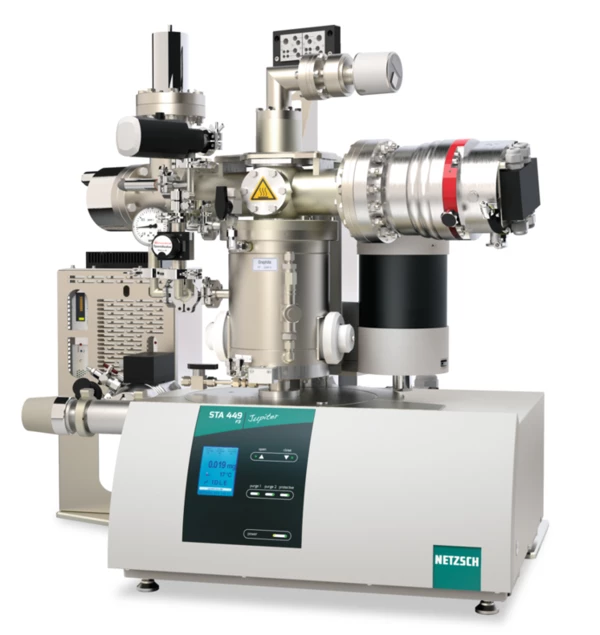
Off to the Future: Digitization and Automation
With the current STA and TG Perseus along with the Aëolos®Quadro, NETZSCH has produced many optimizations in recent years: the fully automatic PTA Box, the GC with its own valve box and coupling to Jeol as well as the new Skimmer.
The software has also been significantly optimized. Some points worth mentioning include the software integration, the complete integration of the Aëolos®Quadro, the control of the PTA and GC valve box via the Proteus® software, the easy evaluation of 3D plots and the ability to access the database search with just one click. Further improvements are planned.
More Information about our coupling systems can be found on our Website!